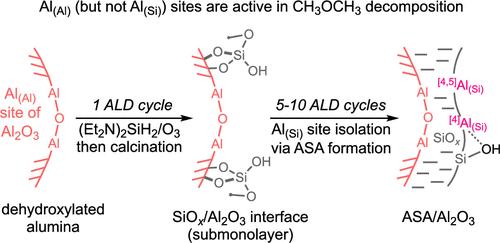Local Structure and Surface Acidity of Overlayers Prepared by Atomic Layer Deposition of Silica on Alumina
IF 7
2区 材料科学
Q2 CHEMISTRY, PHYSICAL
引用次数: 0
Abstract
Understanding the structure of the silica–alumina interface and the reactivity of such interfacial sites in amorphous aluminosilicate (ASA) materials is essential due to their industrial utilization as solid acid catalysts. Here, we link the structure of silica layers grown on alumina by atomic layer deposition (ALD) to the acidic and catalytic properties of ASA. In particular, we study the local structure of silica overlayers as a function of the number of ALD cycles applied and reveal how the coordination environment of Al and Si sites governs the Lewis and Bro̷nsted acidity and catalytic activity using methanol dehydration as a model structure-sensitive reaction. Relying on advanced solid-state NMR characterization, including 27Al{29Si} dipolar heteronuclear multiple-quantum coherence (D-HMQC) and 29Si{27Al} dipolar-mediated refocused insensitive nuclei enhanced by polarization transfer (D-RINEPT) experiments, dynamic nuclear polarization surface-enhanced NMR spectroscopy (DNP SENS), and infrared spectroscopy using probe molecules (CO, pyridine), we demonstrate that the atomic-scale mixing of silica and alumina generates strong Bro̷nsted acidity and increases the strength of the Lewis acid sites. Our findings indicate that the density of acid sites is closely related to the coverage of the alumina surface by silica and can be controlled by the number of ALD cycles applied. This study advances our understanding of the relationship between the local environment of Si and Al sites, the abundance and strength of acid sites, and the superior high-temperature selectivity of SiOx-Al2O3-based catalysts in methanol dehydration when compared to unmodified alumina.

二氧化硅在氧化铝上原子层沉积制备覆层的局部结构和表面酸度
了解二氧化硅-氧化铝界面的结构和非晶硅酸铝(ASA)材料中这种界面位点的反应性对于它们作为固体酸催化剂的工业应用是必不可少的。在这里,我们将原子层沉积(ALD)在氧化铝上生长的二氧化硅层的结构与ASA的酸性和催化性能联系起来。特别是,我们研究了二氧化硅覆盖层的局部结构作为ALD循环次数的函数,并揭示了Al和Si位点的配位环境如何控制Lewis和Bro序列的酸度和催化活性,使用甲醇脱水作为模型结构敏感反应。依托先进的固态核磁共振表征,包括27Al{29Si}偶极异核多量子相干(D-HMQC)和29Si{27Al}偶极介导的极化转移增强的重聚焦不敏感核(D-RINEPT)实验、动态核极化表面增强核磁共振波谱(DNP SENS)和利用探针分子(CO、吡啶)的红外光谱,我们证明了二氧化硅和氧化铝的原子尺度混合产生了强的Bro - nsted酸性,并增加了Lewis酸位点的强度。我们的研究结果表明,酸位点的密度与二氧化硅对氧化铝表面的覆盖密切相关,并且可以通过应用ALD循环的次数来控制。该研究加深了我们对Si和Al位点的局部环境、酸位点的丰度和强度以及siox - al2o3基催化剂在甲醇脱水中的高温选择性之间的关系的理解,与未改性的氧化铝相比。
本文章由计算机程序翻译,如有差异,请以英文原文为准。
求助全文
约1分钟内获得全文
求助全文
来源期刊

Chemistry of Materials
工程技术-材料科学:综合
CiteScore
14.10
自引率
5.80%
发文量
929
审稿时长
1.5 months
期刊介绍:
The journal Chemistry of Materials focuses on publishing original research at the intersection of materials science and chemistry. The studies published in the journal involve chemistry as a prominent component and explore topics such as the design, synthesis, characterization, processing, understanding, and application of functional or potentially functional materials. The journal covers various areas of interest, including inorganic and organic solid-state chemistry, nanomaterials, biomaterials, thin films and polymers, and composite/hybrid materials. The journal particularly seeks papers that highlight the creation or development of innovative materials with novel optical, electrical, magnetic, catalytic, or mechanical properties. It is essential that manuscripts on these topics have a primary focus on the chemistry of materials and represent a significant advancement compared to prior research. Before external reviews are sought, submitted manuscripts undergo a review process by a minimum of two editors to ensure their appropriateness for the journal and the presence of sufficient evidence of a significant advance that will be of broad interest to the materials chemistry community.
 求助内容:
求助内容: 应助结果提醒方式:
应助结果提醒方式:


